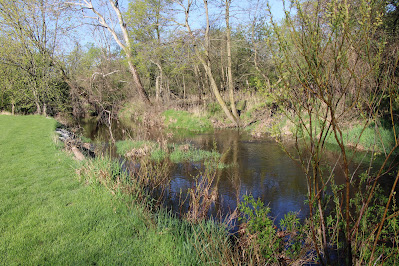The early morning sky is mostly sunny with temperatures in the mid 60’s as I, once again, enter a conservation easement of the Chippewa Watershed Conservancy for my annual inspection of this 38 -acre Gratiot County property. Right away, I spot the head of a Whitetail buck sticking out of tall grasses, displaying his velvet-covered antlers. Most bucks will complete their antler growth in the middle of August. In late August through mid-September, the velvet dries up and they rub it off. Just ahead, I notice a Milkweed beetle resting on a Milkweed leaf. Like Monarch butterflies, these beetles accumulate cardenolides from Milkweed, making them unpalatable to predators, a defense they advertise with their striking orange and black markings. Continuing along, I watch a Bumblebee and a small Sweat Bee feed on small yellow blossoms of Common Mullein. Sweat bees are important pollinators for many wildflowers. As their common name suggests, these bees are attracted to the salt found in human perspiration. Off in a distant field, I look at and listen to a breeding pair of Sandhill Cranes. These lovely birds mate for life - which can mean two decades or more - and stay with their mates year-round. Looping back, I find some Hairy Vetch plants with their lovely purple blossoms. This plant is a highly effective nitrogen fixer, extracting nitrogen from the atmosphere and making it available to plants in the soil, reducing the need for synthetic fertilizers. Pausing at one of several ponds, I first listen to a few Green Frogs and then spot a needle-like Bluet Damselfly perched above the water on blade of grass. Nearby, I see a Cabbage-white Butterfly feeding on Catnip blossoms. This butterfly is a common species whose caterpillars, called cabbageworms (stock photo) are considered a significant pest of crops like cabbage, kale, and broccoli. On my way back to the car, I pass a large patch of Chamomile blossoms. This plant has been used for centuries for its medicinal effects. It is commonly consumed as an herbal tea and is also used in cosmetics and aromatherapy. Nearing the car, I spot a Japanese Beetle resting on a False Sunflower blossom. This native Japanese insect, first discovered in the US in 1916, is a significant pest of landscape trees and shrubs as well as vegetable and fruit crops.
Beauty of summer
settles over the water
where a cardinal flower
flaunts its scarlet pedals,
a wood duck drake parades
its coat of many colors.
In the murky depths
beauty awaits its cue.
An unsightly creature
heeds its inner call to
ascend and transform.
Behold! Dragonfly,
adorned with translucent
wings and body of
iridescent green.
D. DeGraaf
















